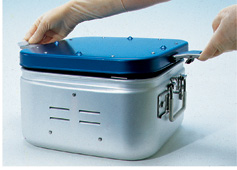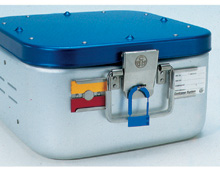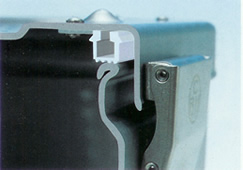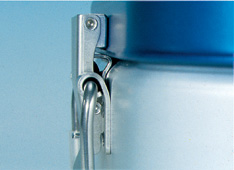.jpg)
The C.B.M. container system represents the best choice for modern sterilizing centers. The flexible nature of the extremely large range of available containers offers to the operators an answer for every requirement in matters of packaging and transporting surgical apparatus. C.B.M. is, in fact, the only producer with the capability of proposing such an extensive assortment of dimensions, materials and different filtering systems, as well as a wide selection of accessories, conforming to the quality requirements of European standard regulations.
Download the
C.B.M., to manufacture the containers, uses materials thatc onform to the provisions of EN 868 Standards:
-stainless steel (X5 Cr Ni 18/9-10), has hardness and rsistance to oxidizing agents that have been successfully tested for years in the hospital container sector;
-aluminium (alloy 5005) offers thermal capacities and great handiness in movements.
However, while steel does not require any surface protection, aluminiuim, by its nature, needs an anodizing process to make its surfacesteam-proof.
Besides the classical anodizing process (mild/coloured according to which dilferently coloured lids may be obtained, so that the pertaining ward or contents may be more easily identified, C.B.M. uses a hard anodizing process.
Such an electrolytic process produces aluminium oxide on the materiale surface and gives it a higher resistance. Hard anodizing process is suitable for the finishing of items subjet to heavy stresses, such as pistons and internal parts of firearms. It has only one colour darkening proportionally to the increase of oxide, getting a more and more burnished colour.
Thanks to this treatment the characteristics of lightness and heat capacity of aluminium remain unchanged, while mechanical characteristics improve.
The main parts of the container, body and lid, re pressed into one piece, so that welding is avoided.
In fact welding thermally strains the material and alters the internal structure of the alloy, changing its characteristics in the welding area.
For the same reasons the assembling of the components is carried out through riveting with X5 Cr Ni18/9-10 stainless steel bolts.
Gaskets both on the lid and on the filter block, are in non-toxic silicone.
Top

The C.B.M. lid closure lever offers extremely high guarantees of safe and aseptic opening, as it is not at all necessary to touch the body of the container in order to release and lift the lid in a stable way.

To ensure that the container has not been opened after sterilisation until it is ready to be used, the stainless container has a plastic security seal.
This seal, placed before sterilisation, breaks immediately when the lid is raised.

The special border worked around the upper edge of the container, made by “Edging” machines, gives the containers added strength.
Moreover, with this technique it is possible to increase the pressure exerted by the lining of the lid, so its resistance to microbes, without damaging the structure of the rubber.
This quality is necessary to eliminate the probability of finding deformations or cuts caused by the stress of transport and stacking.

To facilitate transport and to allow balanced movement our Containers have two central handles, which are very strong yet at the same time comfortable. The stainless steel structure has been created to stand a notable weight that is greater even that the maximum load of the container.
The silicon rubber coating allows for a soft grip and guarantees protection against burns.
The size of the handles mean the finger can easily be inserted and 180° self-stabilising system protects hands from knocks against doorframes.

The steel containers also have a holder into which a single-use label is inserted, identifying the load, also containing a Class A chemical indicator (EN867-2 norm) which changes colour when the container goes through the sterilisation process.

The markings on the body and the lid and all the parts that make up the Container have been studied in order to facilitate cleaning after every use.
The edge of the body and all the borders have been treated to prevent the lining and the operator from being cut.
Top
Sterilization method |
||||||
EN 285 |
DIN 58946-1 |
|||||
| Gravitational | Pre-vacuum | Fractionate vacuum | Preliminary fractionated injection | Steam injection | ||
| Textile in container with filter in the lid and in the body | ||||||
| Textile in container with filter only in the lid | ||||||
| Textile in container with filter only in the body | ||||||
| Instruments on perforated basket in container with filter only in the lid | ||||||
| Instruments on perforated. basket in container with filter only in the body | ||||||
| Textile in container with lateral filters | ||||||
| Instruments on perforated basket in container with lateral filters | ||||||
| Textile in container with protected valves in the lid | ||||||
| Instruments on perforated basket in container with protected valves in the lid | ||||||
Legend |
||
Top
external dimensions (mm) |
useful loading dimensions (mm) |
max. load gross weights (Kg) |
||||||||||
lenght |
width |
height |
opening lenght |
opening width |
useful loading height |
metal load |
textile load |
|||||
INOX |
ALU |
INOX |
ALU |
1F |
2F |
FL |
VALV |
EN 868-8(4.2.8) |
EN 285(26.6.6) |
|||
600 |
300 |
260 |
560 |
561 |
260 |
261 |
224 |
207 |
250 |
228 |
10 |
7,5 |
600 |
300 |
210 |
560 |
561 |
260 |
261 |
174 |
157 |
200 |
178 |
8,1 |
6,1 |
600 |
300 |
160 |
560 |
561 |
260 |
261 |
124 |
107 |
150 |
128 |
6,2 |
4,6 |
600 |
300 |
135 |
560 |
561 |
260 |
261 |
99 |
82 |
125 |
103 |
5.2 |
3.9 |
600 |
300 |
110 |
560 |
561 |
260 |
261 |
74 |
57 |
100 |
78 |
4,2 |
3,2 |
460 |
300 |
260 |
408 |
410 |
258 |
261 |
224 |
207 |
250 |
228 |
7,7 |
5,8 |
460 |
300 |
210 |
408 |
410 |
258 |
261 |
174 |
157 |
200 |
178 |
6,2 |
4,6 |
460 |
300 |
160 |
408 |
410 |
258 |
261 |
124 |
107 |
150 |
128 |
4,7 |
3,5 |
460 |
300 |
135 |
408 |
410 |
258 |
261 |
99 |
82 |
125 |
103 |
4,0 |
3,0 |
460 |
300 |
110 |
408 |
410 |
258 |
261 |
74 |
57 |
100 |
78 |
3,2 |
2,4 |
300 |
300 |
260 |
260 |
261 |
260 |
261 |
224 |
207 |
250 |
228 |
5,0 |
3,8 |
300 |
300 |
210 |
260 |
261 |
260 |
261 |
174 |
157 |
200 |
178 |
4,0 |
3,0 |
300 |
300 |
160 |
260 |
261 |
260 |
261 |
124 |
107 |
150 |
128 |
3,1 |
2,3 |
300 |
300 |
135 |
260 |
261 |
260 |
261 |
99 |
82 |
125 |
103 |
2.6 |
1.9 |
300 |
300 |
110 |
260 |
261 |
260 |
261 |
74 |
57 |
100 |
78 |
2,1 |
1,6 |
Top
- Use only neutral Ph products to clean the containers (Ph 7-8)
- Do not use detergents or disinfectants that contain chlorides.
- Only steel parts can be cleaned using soda – base products..
- Seals can be cleaned using cotton dampened with alcohol.
- Do not use abrasive products.
- Check the condition of the seals with every load.
Top
A container can maintain sterile conditions for up to 6 months when the following recommendations are complied with:
- the storage site must be dust-free;
- the storage site must have controlled pressure, temperature and humidity;
- the storage site surfaces must be smooth and easy to disinfect;
- the first shell of shelving must be at least 30 cm. above the floor level;
- air flows must be controlled;
- all operating, maintenance and cleaning instructions furnished by the manufacturer of the container must be complied with.
(DIN 58953-9 Standards 2002)
Top
| 2007/47/CEE | Directive,September 5th 2007- Medical Device; |
| EN 556 | Sterilization of Medicai Devices - Requirements for medical devices that carry the "sterile" message; |
| EN 285 | Sterilization of Medicai Devices -Large steam sterilizers |
| EN ISO 11607-1:2009 | Packaging for terminally sterilized medical devices - Requirements for materials, sterile barrier systems and packaging systems |
| EN 868-3 | Systems and materials for medical devices that must be sterilized- Paper for use and manufacture of paper containers-Requirements and test methods |
| EN 868-8 | Systems and materials for medical devices that must be sterilized - Reusable containers for steam sterilizers conforming to EN 285 Standards |
| EN 10088-1 | Stainless steels |
| EN ISO 11140-1 | Sterilization of health care products - Chemical indicators |
| EN 868-2 | Systems and materials for medical devices that must be sterilized - Sterilization pack- Requirements and test methods |
| EN ISO 9001:2008 | Quality system |
| UNI EN ISO 13485:2004 | Medical Devices -Quality management systems |
| EN ISO 11607-2:2006 | Packaging for terminally sterilized medical devices - Validation requirements for forming, sealing and assembly processes |
Top